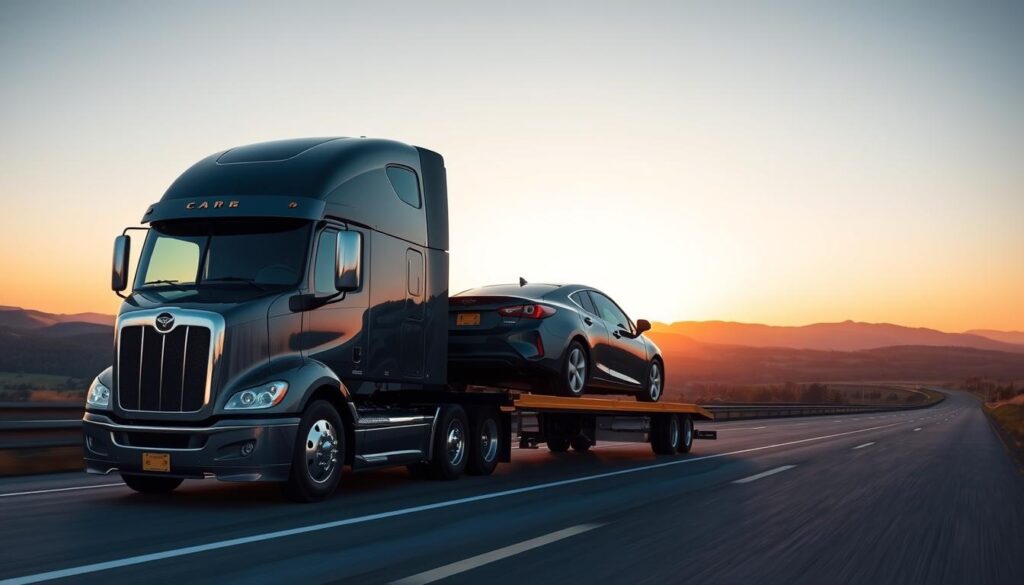Need a reliable plan to move a car across the border without surprises? Many owners worry about costs, paperwork, and transit time. This guide gives a clear overview so readers can plan with confidence.
Professional carriers routinely move autos between Arizona, Texas, and Massachusetts and destinations like Saskatchewan or Winnipeg. Typical rates range roughly $1,000–$2,500, with an industry average near $1,750 and transit often taking about 10–14 days.
Partnering with an established company reduces delays and hands-offs. Reputable providers handle routing, customs forms and RIV compliance, and offer door-to-door or terminal delivery choices. That means clearer timelines and fewer surprises for the owner.
Key Takeaways
- Price bands and timing: Expect $800–$2,500 and about 10–14 days transit.
- Why use pros: One accountable point of contact and end-to-end paperwork handling.
- Protection options: Choose transport that balances cost, risk, and speed.
- Owner vs. carrier: Owners provide documents; carriers manage routing and customs.
- Next step: Request an accurate quote with origin, destination, and car details for a firm plan.
Understand the Basics: Shipping a Car from the United States to Canada

Many owners choose transport when long distances, winter roads, or tight schedules make driving impractical.
User intent and when to choose auto transport vs. driving
If relocating, on an extended stay, or moving a recent car purchase in the united states, moving the car makes sense.
Choose transport for long corridors, winter lanes, limited time, or when avoiding wear and extra miles.
Key players: company, customs, and the RIV
The arranging company coordinates carriers, routes, and billing as one contact point.
Customs authorities clear export and import steps. The Registrar of Imported Vehicles ensures compliance for imported vehicles.
Typical timelines and routes
Most moves go by truck with consolidated loads. Common lanes include southern-to-prairie and Northeast-to-central corridors along major usa canada routes.
Average transit time is about 10–14 days, though weather and demand change schedules.
| Route | Mode | Typical Time | Notes |
|---|---|---|---|
| Arizona → Saskatchewan | Truck (multi-stop) | 10–14 days | Seasonal demand affects capacity |
| Texas → Edmonton | Truck (consolidated) | 11–15 days | Longer distance, verify pickup windows |
| Massachusetts → Winnipeg | Truck (regional lanes) | 9–13 days | Busy corridor, book early |
Tip: Provide documents early, expect status updates at pickup, border clearance, and delivery. Book ahead during peak periods to control cost and timing. Contact Best Car Shipping Inc. at (307) 288-5972 or info@bestcarshippinginc.com for tailored answers about factors that affect time and price.
Step-by-Step: vehicle shipping from us to canada

Start by organizing paperwork and deadlines so the move goes smoothly and without last-minute border hold-ups. A short checklist and a confirmed pickup window will reduce wait time and uncertainty.
Prepare documents and U.S. export clearance
Gather title or ownership papers, bill of sale, valid ID, and lender authorization if a lien exists. Coordinate U.S. export clearance early and verify any port notice requirements.
Book transport and choose pickup
Contact a reliable company, confirm car details, and select door-to-door or terminal pickup. Choose door service for a full end-to-end option or terminal delivery to save cost.
Border crossing, customs, and delivery
Complete the Vehicle Import E-form (Form-1), print all four pages, and present them at the crossing. The carrier handles customs submission at the border, then moves the car to the final address.
- Prepare the car: remove personal items, take photos, keep minimal fuel.
- After entry: start the RIV process and recall clearance within 45 days.
- Need a firm plan? Request a detailed quote: (307) 288-5972 or info@bestcarshippinginc.com.
Compliance Made Simple: Eligibility, RIV, and Required Forms
Confirming compliance early prevents hold-ups at the border and costly last-minute fixes. Start by checking the Transport Canada Registrar of Imported Vehicles compatibility list. That list shows which models qualify and which will need changes to meet canadian standards.
- Verify eligibility: Use the official registrar imported vehicles Compatibility List so the car will meet canadian rules after any mods.
- Check recalls: Ensure the car has no open manufacturer recalls and collect the recall letter for RIV submission.
- Know exceptions: Modified, multi-stage, or converted models often face extra rules or are ineligible.
- Print Form-1: Complete and print the Vehicle Import E-form (four pages). Paper copies are required at the border.
- Schedule inspection: Book the RIV inspection promptly — standard deadline is 45 days after entry (one year for salvage).
Budget for the RIV fee (about CAD 325 plus tax) and common mods such as DRLs and a km/h speedometer. For authoritative guidance, contact RIV at 1-888-848-8240 or Transport Canada Motor Vehicle Safety at 1-800-333-0371. For hands-on help and further information, call Best Car Shipping Inc. at (307) 288-5972 or email info@bestcarshippinginc.com.
Costs, Taxes, and Duties: What You’ll Pay and Why
Estimate total charges early — transport fees are only one part of the final bill.
Basic shipping rates vary by distance, size, and method. Expect typical quotes near $1,000–$2,500, with an industry average around $1,750. Open trailers lower costs. Enclosed service raises price for added protection.
Taxes, duties, and regulatory fees
Under USMCA, North American-made units often face no duty. Other imports may incur a 6.1% duty. All entries pay 5% GST plus provincial PST or HST. Customs and taxes often add about 20% of total costs.
RIV and inspection costs
The RIV fee is roughly CAD 325 plus tax. Expect extra charges for DRLs, a km/h speedometer, and the inspection itself.
- Core cost drivers: distance, vehicle size, and open vs. enclosed.
- All-in quotes: fuel surcharges, tolls, insurance, and door handling may be bundled.
- Tip: Request a detailed auto transport quote that lists duties, taxes, and any surcharges.
| Item | Typical Range | Notes |
|---|---|---|
| Freight (open) | $800–$1,800 | Economical; exposed on multi-stop trailers |
| Freight (enclosed) | $1,400–$2,500 | Higher protection; limited capacity |
| Taxes & duties | ~5% GST + provincial PST/HST + possible 6.1% duty | Varies by origin and province |
| RIV & mods | CAD 325 + $100–$600 | Inspection and required changes |
Contact Best Car Shipping Inc. for a firm quote and lane guidance: (307) 288-5972 or info@bestcarshippinginc.com.
Choosing Services and Timelines: Methods, Seasons, and Expectations
Service type, seasonality, and corridor density all shape expectations for any long-distance auto move.
Open vs. enclosed transport: Choose open for lower cost and faster availability. Pick enclosed for high-value cars or when weather exposure is a concern.
Timing and Snowbird season: Peak demand runs October through February. Capacity tightens then and lead times lengthen. Book early to protect rate and time.
- Door-to-door simplifies handoffs and reduces coordination steps.
- Terminal options add flexibility if the owner must travel before pickup.
- Confirm how the company coordinates local pickup, linehaul legs, and final delivery.
Plan for contingencies: Ask about weather buffers, insurance terms, condition reports, and communications cadence. Verify if limited personal items are allowed in the trunk before pickup.
Strategy: Compare open vs. enclosed, standard vs. expedited, and door vs. terminal in a simple matrix. Reserve a slot early—ships and carriers in busy corridors like Miami, Los Angeles, Toronto, and Vancouver fill fast.
Conclusion
Plan each step—export clearance, Form‑1, and RIV inspection—to keep the process on track.
Align documents early, confirm recall clearance, and build a budget that includes taxes, duties, RIV fees, and likely modifications. Pick transport and protection that match the car’s value and timing needs. Ask for a written quote that itemizes cost and surcharges.
Expect most usa‑canada routes to move in about 10–14 days and allow extra time for weather or peak season. A professional company will handle customs handoffs, registrar imported vehicles steps, and provide clear updates. For a precise plan and firm quote, contact Best Car Shipping Inc.: (307) 288-5972 or info@bestcarshippinginc.com.
